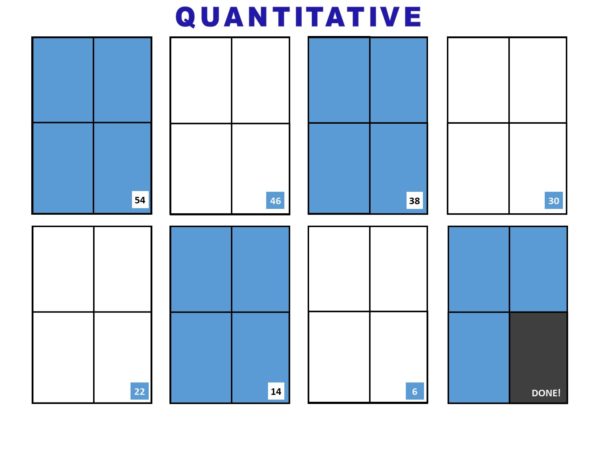
The GMAT’s instructions regarding timing strategy are simple: complete the 31 questions in the quantitative (math) section in 62 minutes, and the 36 questions in the verbal section in 65 minutes. That gives you an average time of two minutes for each GMAT math question, and about one minute and 48 seconds for each GMAT verbal question. If you stick to that pace, you will finish each section right on time. But for most test-takers, that’s easier said than done.
If you have taken a GMAT practice test and run out of time, you know that sinking feeling in your stomach as you realize partway through the section that you’re behind. Then the panic sets in as you try to pick up the pace, constantly checking the on-screen timer and hoping the next question will be faster. Your heart begins to race, and you find yourself reading the same sentence over and over again, unable to comprehend the material because you have one thought filling your mind: “I’m not going to finish all these questions in time!”
This is a challenge many GMAT test-takers face, but fear not! You can overcome this and reach your target score. In this post, we’ll discuss why timing is so tricky—but important—on the GMAT, some general best practices for proper time management, and specific tips for completing the quantitative and verbal sections in the allotted time.
Table of Contents
- Why Time Management Is Tricky on the GMAT
- General GMAT Time Management Strategies
- Verbal Timing Strategies
- Quantitative Timing Strategies
- GMAT Timing Strategy: A Summary
Why Time Management Is Tricky on the GMAT
GMAT questions are designed to test not only your math and verbal knowledge, but also your ability to reason under serious time constraints. That’s why the sections are called “Quantitative Reasoning” and “Verbal Reasoning,” not just “math” and “verbal.” The questions are intentionally written to trick you into solving inefficiently. You need to use your reasoning skills to figure out how to quickly solve problems by “outsmarting” questions that seemingly involve time-consuming calculations or unnecessary extra details. That’s why it’s so critical to always practice under timed conditions for the GMAT. If you prepare with no timer, you’re really studying for a very different test than the one you’ll be taking! On the GMAT, understanding a question and solving it efficiently are one and the same.
The First Five Questions Myth
A popular story in GMAT circles is that the first part of the test is the most important. Many claim that the GMAT algorithm “knows” your GMAT score after only the first five questions and the rest of the test doesn’t make too big of a difference. While nobody—except for the GMAT test-makers—knows exactly how the algorithm works, do not try to game the system by spending most of your time at the beginning of the section.
If this GMAT timing strategy actually worked, everyone would spend the entire time trying to get right answers on the first five questions, and pacing wouldn’t matter! The reality is that the best way to maximize your score is to spread your time out over the entire section, maximizing the number of questions you get right, and making sure you don’t leave unanswered questions (lest you suffer a penalty for not finishing).
Trying to solve quantitative problems more quickly? Learn How to do GMAT Math Faster.
General GMAT Time Management Strategies
Timing Benchmarks
There are a few best practices for managing time that can help you with your pace on all GMAT sections. For test-takers who often run out of time, knowing where you are in the test is often the most important! If you don’t know whether you’re ahead or behind, it’s almost impossible to implement the other pacing strategies effectively, because you don’t know how much to speed up. The solution to this problem is timing benchmarks, which are pace ‘check-ins’ or guides that-test takers memorize so they know how many questions should be completed by a certain point in the exam.
Count down, not up!
Since the GMAT timer starts with the total time you have for the section and counts down, it’s a good idea to learn your timing benchmarks that way too, so you don’t need to do extra math during the exam to figure out how much time has passed. Below are the guides I use for the quantitative and verbal sections. They are easy to remember and are spaced out so you check in often enough to make adjustments if needed, but not so often that you end up obsessing about the clock and becoming distracted.
| Finish this question # | by the time the on-screen timer shows this many minutes remaining |
| #6 | 55 minutes |
| #12 | 44 minutes |
| #18 | 33 minutes |
| #24 | 22 minutes |
| #30 | 11 minutes |
| Finish this question # | by the time the on-screen timer shows this many minutes remaining |
| #4 | 54 minutes |
| #8 | 46 minutes |
| #12 | 38 minutes |
| #16 | 30 minutes |
| #20 | 22 minutes |
| #24 | 14 minutes |
| #28 | 6 minutes |
For a more detailed explanation of these benchmarks and how to use them, check out my YouTube video on my Top 3 Pacing Tips for GMAT.
Letting Go (Guessing)
If you struggle with pace on the GMAT, it’s often better to guess on a challenging and time-consuming question than to spend so long on it that you run out of time to finish the section. This is especially true in the quant section, where not finishing hurts your score more. More importantly, strategically guessing helps you take control of your test and avoid rushing or panicking, both of which hurt your ability to think clearly.
Ideally, you’ll be able to eliminate some answer choices so you can make an educated guess. If not, you’ll still have a one in five (or 20%) chance of success, which is better than the 0% chance of success you face if you don’t get to select an answer at all! Check out this article from the test-maker for a discussion of whether guessing or skipping harder questions leads to a higher score: What’s Your Guessing Strategy for the GMAT Exam?
Practice Tests
Don’t wait until test day to apply these tips! Instead, refine a time management strategy by taking practice tests. Often, you will arrive at a time management strategy that speaks to your strengths and weaknesses. Be sure to take them regularly, not just at the beginning and end of your GMAT preparation, because sometimes timing problems start once your score increases and the questions become harder.
If you haven’t taken a practice test yet, get started with a quick Magoosh Diagnostic Test or check out this post for a list of Free GMAT Practice Test Resources That Will Make You Feel Good About Your Score.
![]()
Verbal Timing Strategies
GMAT Verbal Time per Question: One Minute and 48 Seconds
Remember that on the verbal section, you’ll have about one minute and 48 seconds per question. However, you don’t actually want to spend an equal amount of time on each problem! Some questions require more time, like RC passages, while others take less time, like short SC questions. Each different question type requires a different timing strategy.
-
Reading Comprehension sections should average 6-8 minutes each, and you’ll see about four passages on test day. Short passages have three associated questions, while longer ones typically contain four questions. Spend 2-4 minutes, on average, to read the passage, depending on its length. Don’t waste time reading and rereading details; your job on the read-through is to pick up the main idea of the passage and the attitude of the author. You can always go back to the passage when you’re asked about specific details. Some questions take about 30 seconds to answer, while more challenging ones may last up to 90 seconds.
-
Sentence Correction questions, about 11-13 in all, should take you 60-90 seconds on average, and the more time you can save on Sentence Correction, the more time you’ll have for those tricky Critical Reasoning arguments. Use the differences between the options to spot what rule a question is testing. For example, if option B uses a singular verb while C uses a plural verb, you can immediately recognize that the question is testing subject-verb agreement in number. Spot the subject and determine whether it’s singular or plural.
-
Critical Reasoning questions, 9-11 of them, require you to read the question stem, the argument, and five answer choices. In order to correctly answer the questions, you must fully understand each piece of the argument and how each answer choice connects to the argument. Questions are full of trickily-worded information, including double negations and comparisons about numerical quantities, elements that can easily confuse even the best test-taker if he or she is rushing. Critical Reasoning questions should take no less than 90 seconds to complete. Longer or tougher questions may take upwards of three minutes.
Still getting used to the question types? Learn more about What’s Tested on the GMAT Verbal Reasoning Section and How to Study for GMAT Verbal.
Verbal Page Setup & Cross-out Technique
Keeping your work organized is key on the GMAT, so it’s a good idea to decide how you want to use your available scratch paper and set it up consistently every time. Using a consistent page setup saves time and energy by helping you stay focused on the question, and often reduces test anxiety by keeping you in control of your work. Be sure to test out page setups on practice tests so you can figure out what works best for you. Below is an example of my verbal page setup, which includes the following:
-
Verbal timing benchmarks: Timing guides are listed at the top of the scratchpad so they can be easily referenced throughout the section.
-
Cross-out technique: A simple cross-out technique that allows you to quickly eliminate incorrect answers is laid out below the timing benchmarks. This setup has each letter as a ‘column’, with each question as a ‘row’ below, so you can put an X or a ✓ below each answer choice to indicate a right or wrong answer. It is listed twice so you have enough rows available for all the tricky questions you need to cross out answers on. My rule of thumb is as follows: if you start rereading answer choices to compare them, cross out the other answer choices you have already eliminated so you don’t accidentally read them again or begin to second guess yourself. Using a cross-out technique like this can save a lot of time on the verbal section, and increase your accuracy.
-
Space for notes: The bottom half of the page is left open for other notes, so there is plenty of space to write legibly and neatly without becoming cramped or having to flip the page in the middle of a question.

Quantitative Timing Strategies
GMAT Quant Time per Question: Two Minutes
On the GMAT quantitative section, you have 62 minutes to answer 31 questions; that’s an average of two minutes per question. Budgeting exactly two minutes per question, however, is not a sound strategy. Just like in the verbal section, some questions require more time than others. To give yourself time for more difficult questions, you must solve the easier questions in closer to one minute. Taking practice tests and doing lots of practice questions with careful review is the best way to figure out which questions you can solve faster, and which require more time.
To finish all 31 quantitative questions, remember the tips below:
-
Get started quickly. Don’t agonize over how to get started on a particular question. Start factoring, or draw a Venn diagram; do something!
-
Use all of the information you’re given. If you’re stuck, go back to the prompt and make sure you’ve used all of the information. You may have overlooked a little word like “odd” or “prime.”
-
Know when to move on. Use the time you save on questions you complete quickly to tackle the tougher questions. Remember, if you’ve established sufficiency on a Data Sufficiency question, you don’t need to solve for the answer. Generally, no matter the level of difficulty, you should not spend more than three minutes on any one problem. If you’ve reached the 3-minute mark, and you’re not close to a feasible answer, take your best guess and move on. It’s more important to get to the next question than it is to dwell over the one you’re stuck on and unlikely to get right.
Wondering what kind of math is on the GMAT? See a Breakdown of Quant Concepts by Frequency
Quantitative Page Setup & Cross-out Technique
Staying organized is even more important in the math section, in which most test-takers write many more notes and things tend to get messier. Below is an example of my quantitative page setup, which includes the following:
-
Page division: Most GMAT test-takers use many pages for their math work, and things often get messy. Messy work leads to mistakes, so dividing up each page in advance helps keep things tidy. It also helps you avoid running out of scratch paper in the middle of the math section during the in-person test, which would mean wasting valuable seconds getting a new booklet from the proctor. Each page is divided into four, giving you a quarter of a page for each math problem (four questions per page).
-
Math timing benchmarks: Pace check-ins are written on the bottom right-hand corner of each page of the booklet on the quantitative section so you can see them throughout the test without having to flip back to the first page. Since there is space to do four problems per page, the timing benchmarks we discussed earlier work perfectly! If you set up your pages this way, you would check the timing guide each time you finish a page, before flipping to the next one.
-
Cross-out technique: We can’t predict which questions will be Problem Solving and which will be Data Sufficiency, so no cross out technique is shown on the example. Cross out techniques are usually not needed for Problem Solving questions, but they are very useful for Data Sufficiency! You can quickly write your cross-out method in the related question box whenever you get a Data Sufficiency question. Check out this article for GMAT Data Sufficiency Tips, including a DS cross-out technique.

Note: This setup was designed for the in-person GMAT, in which test-takers are given a multipage scratch paper booklet to do their work on. This allows you to set up multiple pages at once, as shown below. If you are taking the online GMAT, you can follow the same strategy but you would only be able to set up two pages at a time since you’ll have just one double-sided whiteboard.
GMAT Timing Strategy: A Summary
Learn how much time you have on each section
-
– Quantitative section (math): 31 questions, 62 minutes, 2 minutes per problem
-
– Verbal section: 36 questions, 65 minutes, 1 minute 48 seconds per problem
Finish the section
-
– The first five questions are important, but not more important than the rest of the test.
-
– Running out of time before finishing all the questions can hurt your score a lot, especially on the math section.
-
– Use timing benchmarks and page setup techniques to manage your time.
Let go
-
– Strategically guessing on certain problems can be a powerful tool for taking control of your test. This is especially true in the quantitative section, and whenever you find yourself rushing or panicking.
-
– If you’re having trouble finishing a section on time, it’s a good idea to let go of questions that you tend to get wrong, take way too long to solve, or both.
Take practice tests
-
– Be sure to take full-length practice tests regularly so you can figure out if you have any timing issues, and practice applying solutions if you do.
Keep these pacing tips in mind throughout your prep to maximize your GMAT score—and minimize your stress—on test day!





Leave a Reply